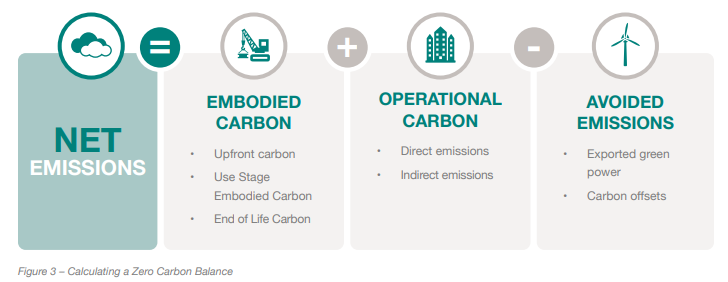Producing Zero Carbon Buildings
Providing tools today that enable the building community to produce market-viable Zero Carbon Buildings by 2030.

(Source: https://www.cagbc.org/cagbcdocs/zerocarbon/v2/CaGBC_Zero_Carbon_Building_Standard_v2_Design.pdf)
Worldwide concern for changes in the global climate has escalated as scientific evidence has become more definitive, linking increased concentrations of atmospheric greenhouse gases (GHGs) with global warming. The standard metric used to quantify different types of GHGs is “carbon dioxide equivalents,” which, for example, is used in global agreements. As jurisdictions across the planet confront climate change, a useful way to describe methods that reduce GHGs is to refer to them as “decarbonization” practices or policies.
With buildings responsible for about 40% of carbon dioxide emissions, many policies are being developed that focus on the decarbonization of buildings. Many jurisdictions are requiring new buildings to be low carbon or net-zero in the near-term and other policies are requiring retrofits of existing building stock in the medium to long term to decarbonize. These decarbonization efforts will require large public and private sector investments, while at the same time creating jobs and business opportunities in the HVAC&R, construction materials and design sectors.
To effectively reduce carbon at the building level, both energy use and carbon emissions need to be reduced simultaneously with the following approach:
- The building demonstrates a zero-carbon balance in its operations over the course of a year.
- Design priorities reducing energy demand and meeting energy needs effectively.
- Onsite renewable energy is used.
- The embodied carbon of the structural, envelope and system materials (primarily associated with manufacturing) is evaluated as part of the design.
To create and recreate the world’s building stock in a manner that sustains the well-being of humanity requires planning, concerted effort and bold action. Formed from our imagination, a single vision must be shared by all who design, build, and operate the structures that house life on our planet and that foster the productivity that defines our civilizations.
A Single Global Definition for Zero Carbon Buildings is Elusive

(Source: https://www.cagbc.org/cagbcdocs/zerocarbon/v2/CaGBC_Zero_Carbon_Building_Standard_v2_Design.pdf)
There is a need to create a single definition of Zero Carbon Buildings (ZCB). Without this, there is a vacuum that leaves questions as to how a building can be universally considered a ZCB. ASHRAE will fill that vacuum.
- Our definition for a net-zero carbon building is a highly energy efficient building that is fully powered from on-site and/or off-site renewable energy sources and offsets. – World Green Building Council
- A zero-carbon building is a highly energy-efficient building that produces onsite, or procures, carbon-free renewable energy or high-quality carbon offsets to counterbalance the annual carbon emissions from building materials and operations. – Canadian Green Building Council
- A zero-net carbon building is defined as a highly energy efficient building that produces on-site, or procures, enough carbon-free renewable energy to meet building operations energy consumption annually. – Architecture 2030/New Buildings Institute/Rocky Mountain Institute
- Net-Zero Carbon Construction; When the amount of carbon emissions associated with a building’s product and construction stages up to practical completion is zero or negative through the use of offsets or the net export of on-site renewable energy. – United Kingdom Green Building Council
Visit ASHRAE’s Task Force for Building Decarbonization KNOWLEDGE HUB

(Source: https://www.cagbc.org/cagbcdocs/zerocarbon/v2/CaGBC_Zero_Carbon_Building_Standard_v2_Design.pdf)
The knowledge hub is currently under development and when available will feature evolving information on decarbonization, that is anticipated to include:
-
- Ratios for converting energy into carbon (grid generation carbon contents, dynamics in the markets)
- Definitions
- Decarbonization
- Net-zero carbon buildings
- Measures of carbon used
- Data
- Energy Usage Baselines such as those available from the Carbon Leadership Forum
- Embodied energy in building materials
- Environmental Product Declaration (EPD) and related resources such as CIBSE TM65
- GHG emissions
- Birth-to-grave certifications
- Archive Declared Decarbonization Goals
- Industry Initiatives
- Cities
- States
- Provinces
- Countries
- Multi-country
- Paris Accord Progress and Developments
- Changes in the decarbonization world
- Available ASHRAE Standards, Guidelines and tools for the industry